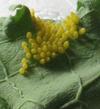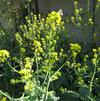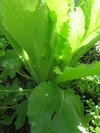Dear Reader, in this age of AI created content, please support with your goodwill someone who works harder to provide the human-made. Sign up at the top of the lefthand column or bottom of this page. You will receive my hand illustrated monthly newsletter RESTORE NATURE and access to the biodiversity garden design course as I write...and nothing else, I respect your time. I am also removing the advertizing as best I can as its become intrusive inappropriate and pays me nothing.
Growing mustard, the easiest multipurpose food plant
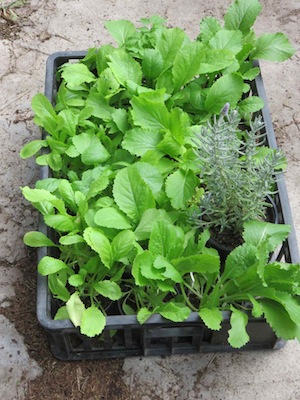 mustard in the making
mustard in the makingversatile mustard, bee food, soil fertilizer, leaf vegetable and spice
Growing mustard is not only easy, but the plant is also incredibly versatile. We may know mustard as a yellow condiment, but this is only one of its uses. It is also a fantastic bee crop attracting bees to your garden, a green manure, a leaf vegetable and a whole spice.
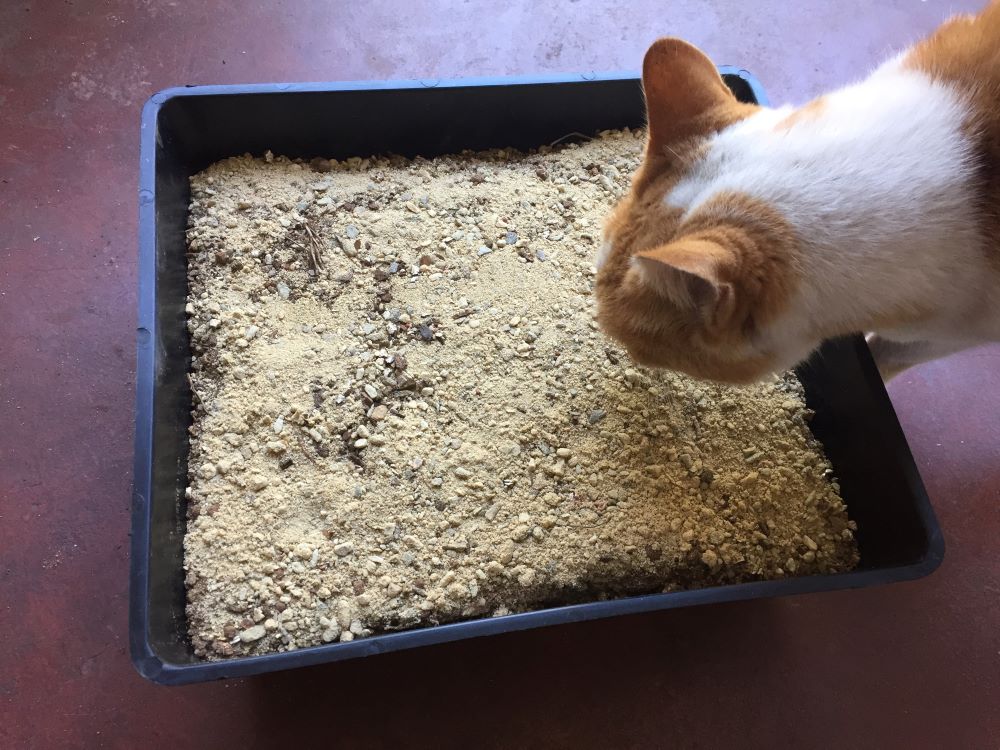 labels avoid confusion labels avoid confusion |
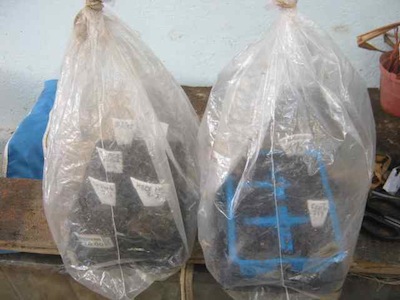 to stabilize moisture to stabilize moisture |
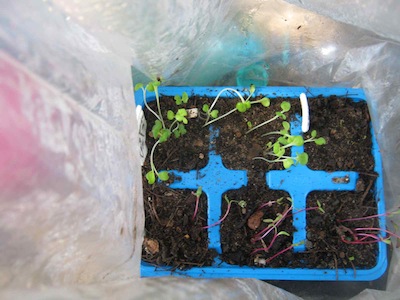 mustard (green) and chard (red) are quick germinators
mustard (green) and chard (red) are quick germinatorsGrowing mustard is this easy
Growing mustard is not going to test your gardening skills. It must be one of the least fussy plants to grow.
Just take mustard seed and sow it in the ground, or in a seed tray and cover with 2mm of fine sand and water it in gently with a very soft spray because the seeds are small and can wash out easily (see my special soft watering rose handmade from old plastic water bottles). If you place them in plastic, which keeps the environment humid, you will not have to water them, just check up on them from time to time. If you sowed in the ground or in open trays take care to water daily, keeping the soil moist. Your mustard will germinate rapidly and start to grow. It will be one of the quickest seeds to germinate in your plant trays so separate it from the other seeds and group it with other fast germinators like Chinese cabbage, or chard, otherwise it will overwhelm the space of other vegetables before they even germinate, and shade them out. I also find that they quickly get lanky in plastic bags, so I keep them in open seed trays.
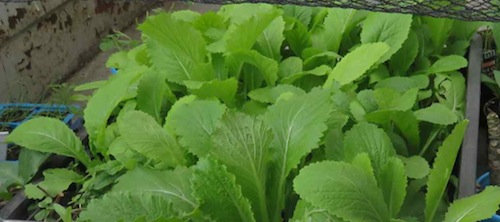 mustard seedlings tend to swamp the others
mustard seedlings tend to swamp the othersThe next step: growing mustard seedlings
At the stage when the two seed leaves have been succeeded by two adult leaves and the plant is about 5cm tall, it pays to transplant otherwise they will just sit without growing if about ten seedlings are crowded into a six pack compartment. For this reason I plant very few seeds at a time, literally two or three seeds per chamber in a six pack, to give them space and nutrients. In a pot about the size of a cup they get big enough to plant out and take well. I have decided to eliminate some of the transplanting and the consequent shocks and stalling of growth by planting a couple of seeds in a plastic tube large enough to take them up to the 20cm six leaf stage. I will then put them in the garden nearly ready to harvest. It is part of a system for increasing productivity that I learned from a wonderful book by an Australian permaculturist. I am applying this system now in my vegetable garden across the board.
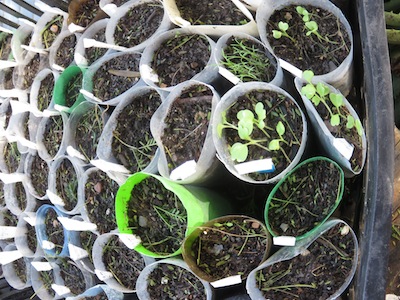 more on the tube system later
more on the tube system laterGrowing mustard in the ground
Perhaps you sowed your mustard seed direct into a garden bed. In that case make sure the soil doesn't dry out too much until they germinate. In South Africa this means daily watering till emergence. If you are growing the mustard in seed trays and have seedlings, plant out the mustard seedlings into a bed with compost, and water daily till they take. They are not terribly demanding in terms of nutrients, but all plants, especially leaf vegetables seem to do better with compost in our climate, because the danger of desiccation is so great and mustard does tend to wilt badly on a hot day. The organic material in the soil stabilizes the water content and holds minerals better.
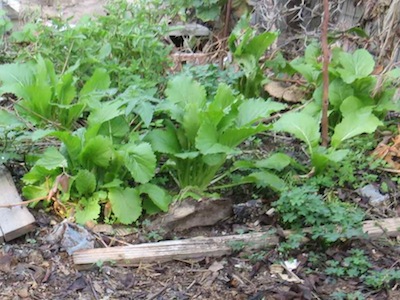 mustard weeks after planting
mustard weeks after plantingHarvesting mustard seed
When the plants flower and set seed, enclose the little green mustard pods in a paper bag before they split or you will lose the seed to the environment. Give them time to ripen thoroughly on the plants, for the pods to go brown and split, then harvest the seeds. The bag may be full of insects but I found they had not damaged the seeds. Perhaps I was lucky. They are tricky to separate from the pods. I crumbled the pods in my hands, but be cautious, the more fine material you create the more difficult the separation becomes. Perhaps just pressing down on the pile will be sufficient. I then put everything in a colander with small holes and rolled it around and the seeds came through with some fine chaff. You could winnow off the chaff, or place it all on a piece of stiff newspaper and gently tilt to let the seeds roll off into a container and leave the chaff behind. It works nicely if you tap the paper a bit., and repeat the process several times.
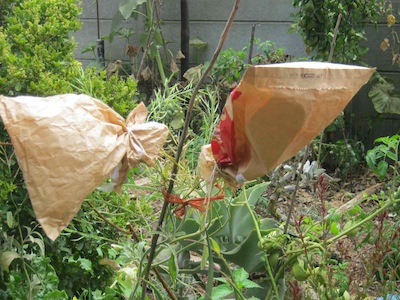 catching your own mustard seed is really simple
catching your own mustard seed is really simpleGrowing mustard from your own garden's seed
My current mustard is own seed, second generation, so it has been partially selected for what grows well and produces seed in our soil. The use of seed adapted to my garden increases water saving, and over many generations they could become really drought resistant. But in this great advantage lies a danger. They could escape into the wild and flourish there and become invaders.
Growing mustard is beneficial to your garden
In the garden growing mustard serves several ecological purposes. The profusion of flowers attract bees to pollinate your vegetables at a suitable time of year, and other beneficial insects to predate the bad insects consuming your crops. Mustard can also be grown en masse and dug under as a green manure.
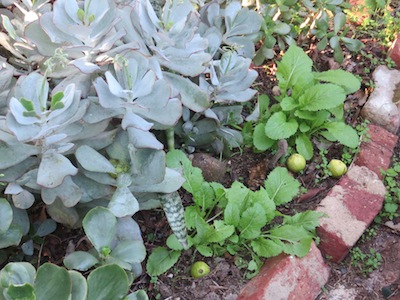 another benefit of mustard, as an edible filler in the garden
another benefit of mustard, as an edible filler in the gardenMustard is a must in the kitchen
You can harvest the young leaves by picking them off the plant one by one without killing the plant. Use the leaves in leaf mixes or for piquant salads or stir fries. Mustard seeds are integral to making vinaigrette, mayonnaise and many other dishes where their burn and tang are required for flavoring as well as their property as emulsifiers, or facilitators allowing oil and water based liquids to mix into a creamy emulsion.
------
home page for many hints on gardening the natural way
------
vegetable gardening the low cost natural way, with a list of the other easiest vegetables to grow
Restore Nature Newsletter
I've been writing for four years now and I would love to hear from you
Please let me know if you have any questions, comments or stories to share on gardening, permaculture, regenerative agriculture, food forests, natural gardening, do nothing gardening, observations about pests and diseases, foraging, dealing with and using weeds constructively, composting and going offgrid.
You’re a home gardener ! Share your experiences and questions !
We all know about home gardening. Tell us about your successes, challenges and ask about issues that bother you. You may have the luxury of a back garden, but there are other ways we learn. Few people age without growing something or buying vegetables during their lives ! It is absolutely guaranteed that you have learned things which can help others on their gardening journey.
We invite you to share your stories, ask questions, because if a thing has bothered you it will bother others too. Someone may have a solution ! No question is too small. There is learning for everyone involved, for you, for me (yes, I learn from every question), for us all. Exciting stuff !
We are starting on a new journey. Every week we will profile your letters ! The best stories and questions we receive.
What Other Visitors Have Said
Click below to see contributions from other visitors to this page...
eggs from a Cabbage White ? 




That white butterfly on the mustard flower looks like a Cabbage White, and the interwebs says we'll soon have a "brassica massacre"... These do look very …
and now they are blooming brassicas 




Flowering mustard and Chinese cabbage are lovely in the late afternoon light, and someone else agrees with me
here is the picture of the dilly dallying dill and allium 




this doesn't belong with mustard but its there as a comparison. Brassica's thriving, the others not, although they are said to be winter vegetables by …
Booming brassicas, dilly dallying dill and allium 




It is 15 June or near mid winter in Cape Town. We have had rain for two weeks and cold weather has also finally arrived. I transplanted Four weeks ago, …
SEARCH
Order the Kindle E-book for the SPECIAL PRICE of only
Prices valid till 30.09.2023
Recent Articles
-
garden for life is a blog about saving the earth one garden at a time
Apr 18, 25 01:18 PM
The garden for life blog has short articles on gardening for biodiversity with native plants and regenerating soil for climate amelioration and nutritious food -
Cape Flats Sand Fynbos, Cape Town's most endangered native vegetation!
Apr 18, 25 10:36 AM
Cape Flats Sand Fynbos, a vegetation type found in the super diverse Cape Fynbos region is threatened by Cape Town's urban development and invasive alien plants -
Geography Research Task
Jan 31, 25 11:37 PM
To whom it may concern My name is Tanyaradzwa Madziwa and I am a matric student at Springfield Convent School. As part of our geography syllabus for this
"How to start a profitable worm business on a shoestring budget
Order a printed copy from "Amazon" at the SPECIAL PRICE of only
or a digital version from the "Kindle" store at the SPECIAL PRICE of only
Prices valid till 30.09.2023
